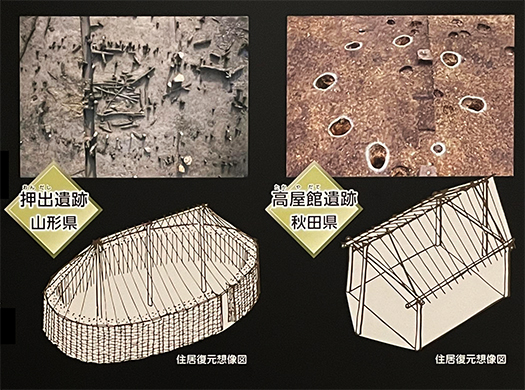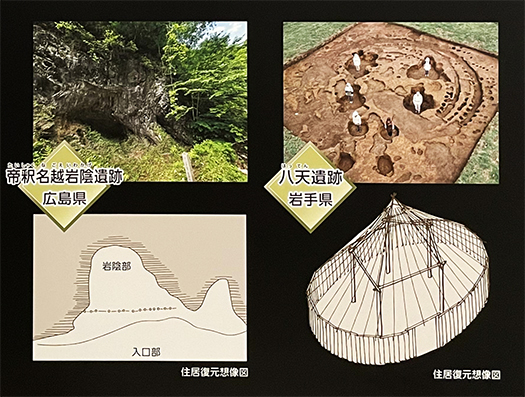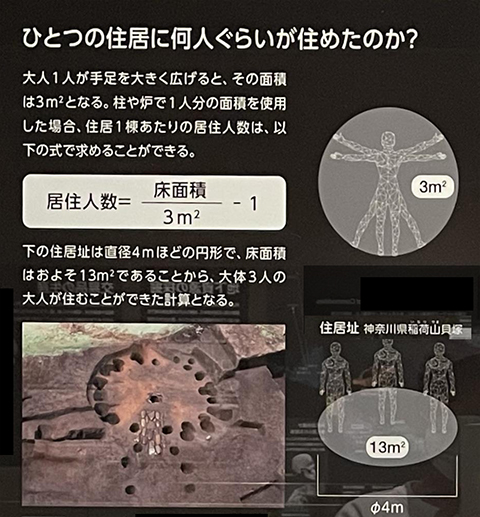


縄文社会の実相を探る国立歴史民俗博物館の探究はたいへん刺激的。
炭素年代法などの考古探究ドリルの切っ先鋭く、文字記録以前の闇を開いて行く。
従来の住宅研究のレベルを超えて興味深い地点に達している。
「各地の住居を復元する」と題された刺激的パネル展示。
わたしのライフワークテーマとぴったり重なる。
このテーマの前振りとして「各地の集落と社会」という解説が以下。
〜集落や墓地のあり方は各地に於いて異なっていた。たとえば中国地方では
全時期を通じて集落も墓域も小規模であるが、中期の関東地方では大規模なものが
形成されており、その社会のあり方も相互に大きく異なっていたと思われる。〜
縄文期の列島での人口分布では関東以北地域が優勢で西日本は
比較的国土利用が活発ではなかったとされている。
温暖化の進展で、むしろ現在の寒冷地域のほうが有利だったのか、
あるいは列島に住み着いた人類はどちらかといえば北東アジアから
マンモスを追って到着した人びとの末裔が主流を形成していたことを表すのか、
最近の日本人のDNA解析では後者の見方に傾きつつあるようだけれど、
これは今後の研究の成果を待たねばならない。期待したい。
で、本題の縄文期に利用され建築された住居の復元について。
〜当時の居住施設にはもっともポピュラーな
・竪穴住居 以外にも
・平地式住居(掘立柱建物)
・洞窟・岩陰住居(広島県・帝釈名越岩陰遺跡)
・屋内に石を敷き詰めたもの(神奈川県・子易大坪遺跡)
・壁で屋根を支えるもの(山形県押出遺跡)
・塀のように板材を巡らせるもの(岩手県・八天遺跡)〜
など、デザイン的にも構造的にも多様なスタイルが存在したとされる。
その地域での環境に整合的に順応し、そして建築を構成する素材も
その地域性を反映して選択されたことがわかる。
わたし的には「板材」を使っている八天遺跡に深く興味を持つ。
本当に板材なのか、確かだとすれば石斧で木材を割ったのか?
奇跡的工法開発と思えるが、これは自然発展かを確認したい。
また、子易大坪遺跡の床面に敷き込まれた石材にも深く驚く。
竪穴にプラスして床面を敷石とするのは「蓄熱性能」への着眼とも思える。
言うまでもなく年中安定した室内気候環境を獲得するのには合目的的。
ほぼ中央部からやや入口側に配置された「囲炉裏場」痕跡にも
そうした工夫を見ることができるだろう。
縄文の人びとも自然な知恵と工夫で、合理的で多彩な住宅に取り組んでいた。
Replan誌では「性能とデザイン」というスローガンを20年近く、
日本の住宅情報シーンで最初に打ち出したと思っているけれど
はるかな先人の取り組みに深く畏敬の念を抱かせられる。・・・

また、縄文時代の家族像・家屋での生活ぶりにも探究のメスが入れられている。
床面積から推定して5-7人程度が住んだとみられるひとつの住居には
核家族が居住し、周辺の複数の住居に3世代程度の家族集団が
まとまっていたと推定されるという。
きのう触れた、家族が集約的に埋葬された墓域(埋葬小群)の規模とも整合的。
縄文の人びとの住へのこだわり、
その工夫ぶりになんとも言えないシンパシー、ハンパない(笑)。
English version⬇
Jomon House “Performance and Design” 37,000 Years of the Japanese Archipelago – 23
Replan magazine describes the orientation of highly insulated houses as “performance and design. We deeply sympathize with the wisdom and ingenuity of our far Jomon predecessors. …
The National Museum of Japanese History’s exploration of the realities of Jomon society is very exciting.
The sharp edge of archaeological exploration drills, such as carbon dating, open up the darkness before the written record.
It has reached an interesting point beyond the level of conventional housing research.
A stimulating panel exhibit titled “Reconstructing Dwellings Around the World.
The theme of the exhibition coincides perfectly with my own life’s work.
The following commentary, “Settlements and Societies around the World,” is a prelude to this theme.
〜The way of settlements and cemeteries differed from place to place. For example, in the Chugoku region
In the Chugoku region, for example, settlements and cemeteries were small throughout the entire period, but in the Kanto region during the middle period, large-scale settlements were formed.
The social patterns of these regions were also very different from each other. ~.
In the Jomon period, population distribution in the archipelago was dominated by the area north of the Kanto region, while western Japan was relatively inactive in terms of land use, and the area north of the Kanto region was relatively small.
The Jomon period population distribution in the archipelago during the Jomon period was dominated by the Kanto region and northward, and western Japan was relatively inactive in land use.
With the advance of global warming, was the present cold region more advantageous?
Or perhaps the humans who settled in the archipelago came from northeast Asia, following the mammoths.
or that the human population that settled in the archipelago was mainly descended from people who arrived after the mammoths from Northeast Asia?
Recent DNA analysis of the Japanese population seems to be leaning toward the latter view.
We will have to wait for the results of future research. We must wait for the results of future research.
Now, to the main topic, the reconstruction of dwellings used and built during the Jomon period.
〜The most popular type of dwelling at that time was the pit dwelling.
In addition to pit dwellings
Plain dwellings (hottate-bashira)
Cave and rock dwellings (Teishaku-Nagoshi Iwa-in Site, Hiroshima Prefecture)
Stone-paved dwellings (Kanagawa Prefecture, Ziye Otsubo Site)
Roof supported by walls (Yamagata Prefecture, Extrusion Site)
A wall supporting a roof (Extrusion Site, Yamagata Prefecture), and a fence with planks (Yaten Site, Iwate Prefecture).
A variety of styles are said to have existed, both in terms of design and structure.
The materials used to construct the architecture were selected to reflect the local characteristics of the area.
The materials used to construct the buildings were selected to reflect the local characteristics of the region.
I am deeply interested in the Yaten site where “wooden planks” are used.
Is it really planks, and if so, were the planks split with a stone axe?
This seems to be a miraculous development of a construction method, but I would like to confirm whether this is a natural development.
I am also deeply surprised by the stone material laid on the floor of the Ziye Otsubo site.
The use of paving stones for the floor surface in addition to the pit seems to be an attempt to achieve “heat storage performance.
Needless to say, it is a purposeful way to obtain a stable indoor climatic environment throughout the year.
The traces of the “sunken hearth” located from the center of the building to the entrance can also be seen.
The Jomon people also had a natural wisdom.
The Jomon people also used their natural wisdom and ingenuity to create rational and versatile housing.
Replan magazine has been carrying the slogan “Performance and Design” for nearly 20 years.
I believe we were the first to launch the slogan “Performance and Design” in the Japanese housing information scene, but
I am in deep awe of the efforts of those who came before us. …
The Jomon family and the way of life in a house are also explored.
A single dwelling, which is estimated to have housed 5-7 people based on its floor space, was occupied by a nuclear family.
A nuclear family lived in one dwelling, which is estimated to have housed 5-7 people based on the floor space, and a family group of about 3 generations lived together in several surrounding dwellings.
The family is estimated to have been clustered in several surrounding dwellings.
This is consistent with the scale of the burial sites (burial sub-groups) where families were buried together, as mentioned yesterday.
The Jomon people’s commitment to housing and their ingenuity are indescribable.
I can’t help but feel an indescribable sympathy for the ingenuity of the Jomon people (laugh).
Posted on 11月 23rd, 2022 by 三木 奎吾
Filed under: 住宅マーケティング, 歴史探訪







コメントを投稿
「※誹謗中傷や、悪意のある書き込み、営利目的などのコメントを防ぐために、投稿された全てのコメントは一時的に保留されますのでご了承ください。」
You must be logged in to post a comment.